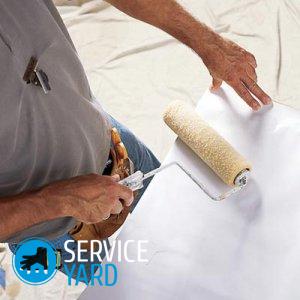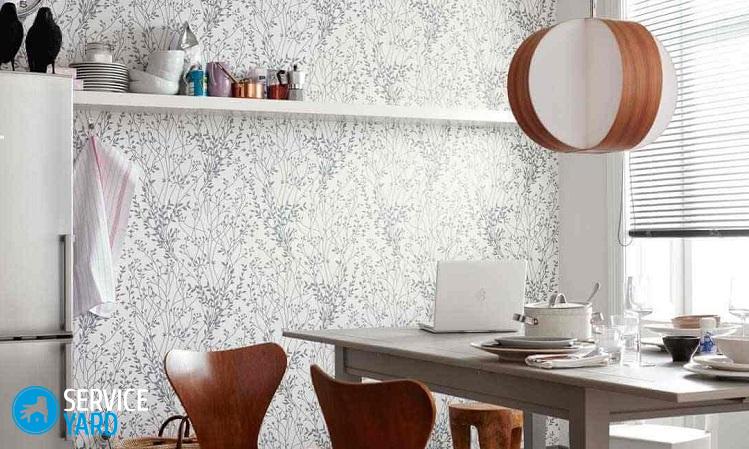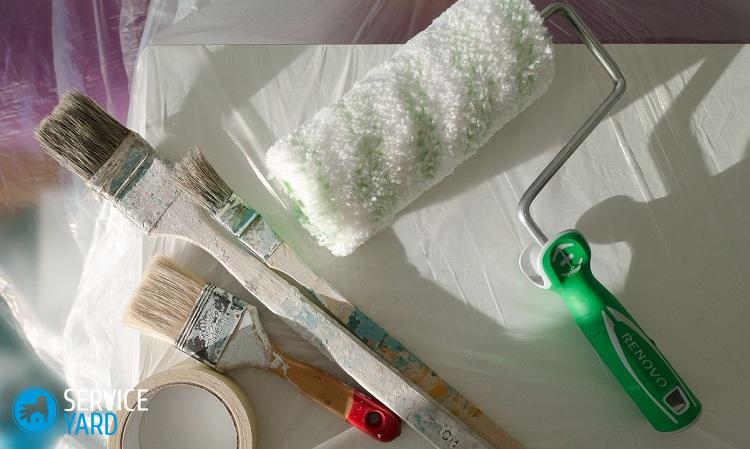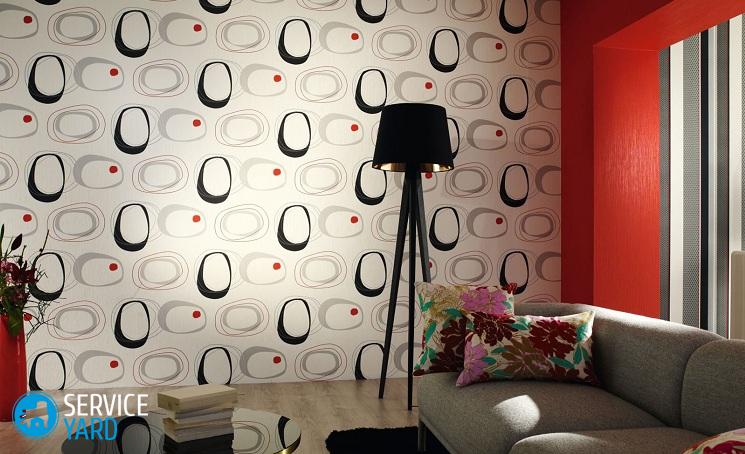How to glue paper-based vinyl wallpapers?

Wallpapering is not so easy as it seems at first glance. Here you need to possess certain knowledge regarding this or that kind. So, for example, vinyl wallpapers come in several varieties, each of which puts forward its own rules and requirements in sticking to the wall. Today we will talk about how to glue paper-based vinyl wallpapers. Due to their positive characteristics, they are the most popular among many users. In order to glue such wallpapers qualitatively and for a long time, we will conduct a detailed master class for you. In our article you will find answers to many questions that interest you. There will be a lot of interesting, and most importantly - useful information!
to contents ↑Advantages and disadvantages
Vinyl wallpaper is a layer of PVC applied to a paper or non-woven fabric. Before you glue wallpaper on a paper basis, you need to know the strengths and weaknesses of this finishing material. So, let's take a closer look at them.
Pros:
- Long service life. Wear resistance is the most important advantage of vinyl wallpapers, which we paid attention to in the first place. Vinyl has several main advantages - it does not fade under the influence of sunlight, copes well with humidity. All this allows you to use the canvas with a picture in the bedroom, in the kitchen and even in the bathroom.
- Easy to apply. This material is easy to glue on absolutely any wall and ceiling (concrete, wood, chipboard, plaster, etc.).
- The ability to mask defects. A dense vinyl layer is able to well hide cracks and other irregularities in the walls. But only the thickest grades of wall covering are suitable for this.
- Large selection of designs. Currently, there are a large number of vinyl wallpapers, different in density, texture and color scheme. Thanks to this, your choice will be greatly simplified, which will allow you to correctly select the coating for the specific interior of your home.
- Ability to choose the size. In stores and markets presented roll and meter version of this material. This is very convenient when you need to make one large purchase or buy the necessary amount of coverage.
- The speed of sticking. Due to the dense structure, glue is applied only to the wallpaper, and not to the wall, which greatly simplifies the entire gluing process and significantly saves time.
Minuses:
- Temperature differences. Vinyl coatings do not cope well with temperature extremes, especially with the effects of hot appliances. That is why we do not recommend sticking them near a fireplace or near a gas stove.
- Poor breathability. Due to its dense structure, the PVC coating practically does not let air through, so the walls do not “breathe”, and even a little ventilation is extremely necessary. This problem can be solved by purchasing special canvases with micropores that pass air well and resist moisture accumulation, which will avoid the appearance of fungus under the wallpaper.
- Difficulty applying on an uneven surface. Vinyl is not a very plastic material with a rather dense base. You need to work hard to paste over the protrusions, roundness, joints and embossed surfaces.
- Vinyl paper wallpapers quickly absorb glue, which increases fluid consumption by several times.
- The paper coating is easy to damage: scratch, tear and so on.
- The adhesion of the wallpaper to the wall is quite long - the strip of wallpaper with glue needs to be applied, pressed against the wall, and then wait a bit.
Varieties
So, we already know the pros and cons of non-woven coating, and now it is time to consider its classification by main parameters.
By structure and type of surface:
- Smooth.
- With relief.
By the method of finishing the vinyl surface:
- Profile.
- Embossed.
By the method of applying the vinyl layer:
- Sprayed.
- In the form of a film.
By embossing method:
- Screen printing. The output is light and smooth wallpaper, which is obtained by applying a thin layer of polyvinyl chloride, due to which various textures are created. Screen printing offers a potential buyer a wide selection of coatings of a variety of designs.
- Compact vinyl. Differs in weight and structure from silk-screen printing. The surface vinyl layer imitates expensive stone, fabrics and various types of plasters.
- Heavy vinyl. Such wallpapers have the thickest surface layer. This type of coating is characterized by high relief and durability, which allows you to create the effect of harvested skin and volume embroidery. Thanks to the embossed vinyl, it allows you to hide the unevenness of the walls.
- Chemical embossed finish. It has a smooth, glossy surface with which it is easy to eliminate any kind of contamination. This finish has increased strength, resistance to fading, moisture and detergents.
to contents ↑Important! The first three types of coating are “hot stamping”. After the foaming process, the vinyl layer is treated with several rollers - clamping and cramping. It is thanks to and receive the necessary texture on the surface of vinyl paintings.
Glue selection
For a certain type of coating, not all glue is suitable, but only one that has a special purpose. Properly selected glue for vinyl wallpaper on a paper basis is the key to success and a guarantee of the durability of this material.
Important! Poor composition can provoke bubbles, irregularities and lagging of the coating from the wall. We recommend giving your preference to foreign manufacturers of glue, which will cost you more than domestic, but will please with their result in the process of use.
Requirements
Basic requirements for glue for plastic wallpapers:
- The glue should fix the canvas well on the wall, but this should not happen instantly. This is necessary so that you have the opportunity to correct the stripes at the joints or align the wallpaper in different directions.
- As we said earlier, vinyl does not allow air to pass through well, so the appearance of microorganisms under the material is, alas, a common occurrence. That is why the adhesive should serve as a barrier to the development of mold and fungus under the coating.
- In the process of mixing the dry composition with the liquid, you should observe the formation of clots and lumps. Such formations can result in defects and even damage to the glued surface.
- Please note that the finished glue can be stored for up to a day without drying. Otherwise, such glue can be considered low-quality.
- The whole process of preparing the adhesive composition should be carried out according to a fairly simple scheme, which anyone can perform.
Important! If you want to feel good further, do not forget that wallpaper and glue should be environmentally friendly and safe for human health.
Cooking composition
Glue must be diluted strictly according to the instructions indicated on the product packaging. Many people believe that the more glue is applied to the ob, the better and stronger they will hold. This opinion is erroneous. On the contrary - excess glue can greatly wet the canvas, go out through the seams and stain the surface of the coating.But if you add more powder to the water, then you get too thick glue, which will cause difficulties in applying.
Instructions for the proper preparation of glue for vinyl wallpaper:
- Pour the composition into water, adhering to the ratio of ingredients on the product labeling.
- Stir the solution thoroughly, breaking the lumps with a construction mixer or any other improvised means.
- We maintain a pause of 2-3 minutes.
- Mix the glue again and leave it to swell for 5-10 minutes.
Now the composition can be applied to the coating.
to contents ↑How to glue paper-based vinyl wallpapers - do I need to smear the wall or not?
Now we will consider the main stages of preparation and direct gluing of PVC wallpaper on a paper basis. So let's get started.
Preparatory work:
- Remove the old coating. We moisten it with water with a rag, brush or roller - to whom it is convenient.
- We give time to impregnate the material, and then remove the old wallpaper with a knife or metal spatula.
- We cover up the dark spots on the wall, as they can appear through the paper web.
Important! This applies only to light colors, on the dark this will not be noticeable.
- If necessary, we level the surface with plaster or putty. Vinyl well conceals many defects, but for silk-screen printing, the wall should be perfectly even.
Important! If you have walls with obvious flaws, we recommend using embossed or matte wallpapers that will mask this problem well. Plain and glossy coatings are only suitable for smooth walls.
- After drying the previously applied mixture, we wipe the wall with a hard-bristled brush, thereby removing dust and dirt.
- Primed surface. The primer can be bought at a hardware store and prepared according to the instructions on the packaging. Ideally, it will include ingredients that prevent mold and mildew.
Important! For priming the wall, you can use wallpaper glue diluted to a liquid state.
How to glue paper-based vinyl wallpapers?
Of course, you can’t do without outside help, since gluing together is better for two: one person holds the smeared strip below, and the other picks up and glues it on the stepladder at the top.
Important! You can paste the walls yourself, but you will often have to jump down and up, and this is extremely inconvenient.
Step-by-step master class on gluing paper-based vinyl wallpapers:
- We close windows and doors, turn off air conditioners and other ventilation in the room where such work will be carried out. This is necessary so that the glued strips do not peel off, air bubbles do not form on the wallpaper.
- We cut the necessary strips, combining a pattern (if one is available). Above and below we leave 5 cm of allowance.
- Fold the wallpaper on a clean floor face down.
- Coat the material with a suitable glue using a wide brush. We are waiting for a few minutes to absorb the composition into the coating. This time depends on the density of the selected material.
Important! It is very important to observe the same interval between applying glue to the next strip so that the “impregnation” of the paintings is the same.
- While the wallpaper is swollen, fold the strip twice the wrong side inward, trying to avoid creases. While we glue one strip, two swell and wait for their turn. They glued one canvas - they missed the next one, which they left to swell, and so on.
- We start gluing from the corner of the room. Level the front line with a plumb line. You will simplify your task by marking vertical lines on the surface of the walls. We apply the wallpaper from above, align it vertically, and then press it with a hand or roller in the very center along the entire length of the canvas.
- Now we smooth the entire surface with a roller, thereby expelling excess air and glue. Press the edges, moving in the direction from the center to the sides.
- We remove excess glue with a dry and clean rag. Apply glue with a thin brush to poorly glued edges.
- We apply the next strip to the first, making sure that the wallpaper does not stretch, which can form an irreparable gap after they dry. If nevertheless this could not be avoided, then separate the edge of the sheet from the wall, smear again with glue, allow time to swell the paper, and then stretch the sheet and close the visible gap.
- We withstand pasted vinyl wallpapers for two, observing room temperature conditions and the absence of drafts.
to contents ↑Important! The glue is applied only to paper-based vinyl wallpapers, and in the case of non-woven ones, only to the wall. Here is the answer to the question of how to glue vinyl wallpapers on a paper basis - should I smear the wall or not.
Stock footage
We really hope that our article was useful to you. We tried to put a maximum of information into it, both about the vinyl wallpaper itself and about the way they are sticker. Follow our recommendations, tips and you will achieve the desired result. Have a good repair!
- How to choose a vacuum cleaner taking into account the characteristics of the house and coatings?
- What to look for when choosing a water delivery
- How to quickly create comfort at home - tips for housewives
- How to choose the perfect TV - useful tips
- What to look for when choosing blinds
- What should be running shoes?
- What useful things can you buy in a hardware store
- Iphone 11 pro max review
- Than iPhone is better than Android smartphones






